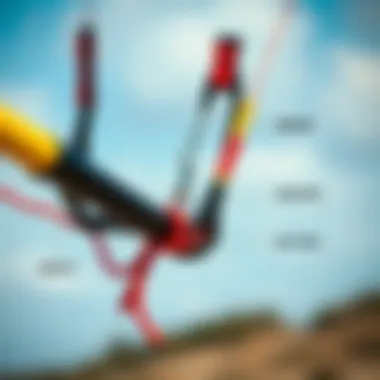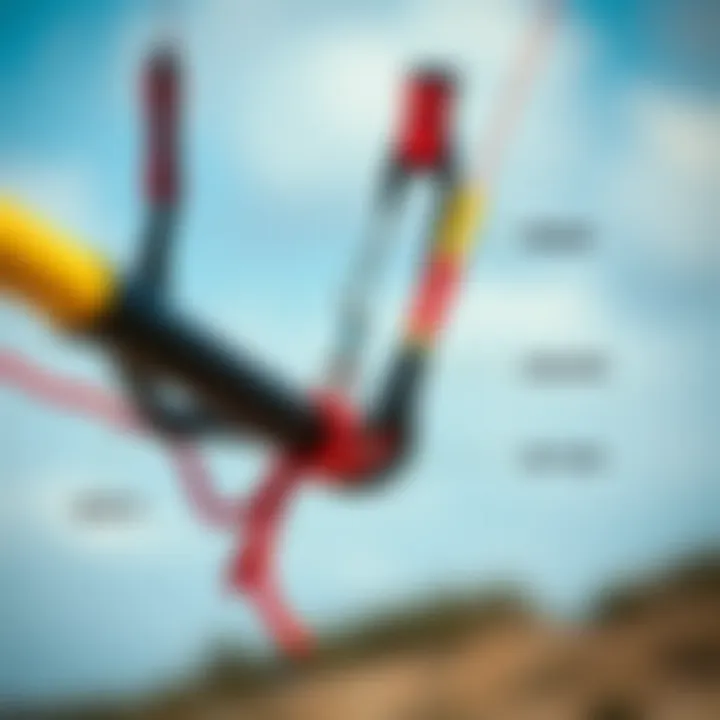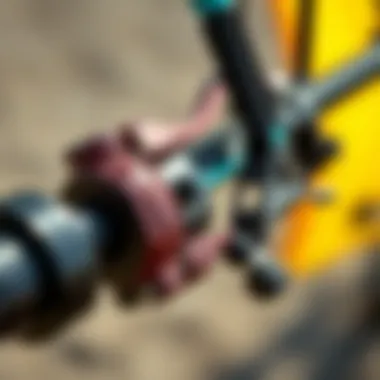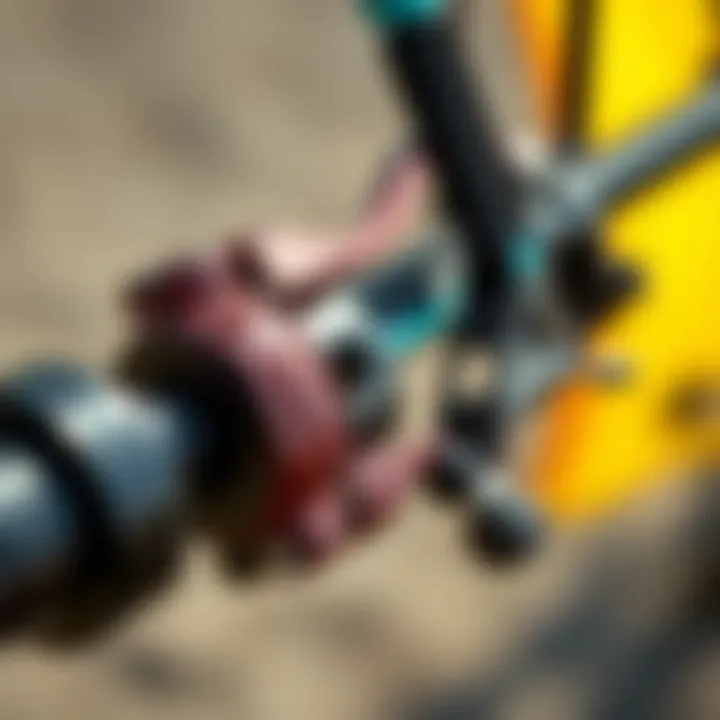The Slingshot Kite Bar: A Comprehensive Review


Intro
Kiteboarding has surged in popularity over the years, captivating adventure seekers and sports enthusiasts alike. At the heart of this exhilarating sport is the kite bar, specifically designed for steering and controlling the kite. Among the many options available, the Slingshot kite bar stands out, boasting innovative features that speak to both functionality and safety.
In this article, we will explore the intricate aspects of the Slingshot kite bar. From its design decisions to the materials used, we'll uncover how these elements affect performance on the water. Understanding equipment selection can significantly impact one’s kiteboarding experience, whether you’re a novice rider or an experienced pro.
This discussion aims to equip kiteboarding enthusiasts with valuable insights. With a deep dive into safety features, adjustment mechanisms, and comparisons with competing systems, readers will learn to make informed choices for better performance and enjoyable rides.
Gear and Equipment
When starting with kiteboarding, having the right gear makes all the difference. The foundation of a successful ride begins with a well-suited kite bar.
Essential Kiteboarding Gear for Beginners
For those new to kiteboarding, the initial gear setup might feel overwhelming. Here’s a concise rundown of necessities:
- Kite: The kite itself is the most crucial element. Look for one that matches the local wind conditions.
- Harness: A comfortable harness supports your body and connects you to the kite bar.
- Safety Leash: This ensures that, in case of a mishap, your kite does not drift away uncontrollably.
- Life Jacket: Personal flotation devices are non-negotiable for safety on the water.
- Board: Choose a board that suits your skill level; a larger board is great for beginners.
Proper understanding and selection of these items set the stage for enjoyable sessions on the water.
Advanced Equipment for Experienced Riders
For seasoned kiteboarders, performance-enhancing gear becomes paramount. Advanced riders should consider the following additions:
- Carbon Fiber Kite Bar: Reduces weight for better maneuverability.
- Quick Release Mechanism: This offers heightened safety, allowing for rapid detachment under stress.
- Customizable Line Lengths: Tailoring line lengths under various conditions can provide significant performance advantages.
- High-Performance Kite: More advanced designs cater to higher speeds and better control in challenging environments.
Choosing the right advanced equipment not only elevates performance but also enhances overall experience in the sport.
Techniques and Tips
With the right gear in hand, let’s pivot to essential practices and techniques that can enhance your skills and ensure safety.
Safety Practices for Kiteboarding
Safety should always be the priority while kiteboarding. Here are some sound practices:
- Pre-Flight Checks: Before hitting the water, inspect your kite bar, lines, and kite. Look for any signs of wear or damage.
- Understand Wind Patterns: Knowledge of wind direction and changes can prevent accidents.
- Always Use a Safety Leash: It may prevent your kite from drifting away, especially when you're in distress.
- Ride with a Buddy: Kiteboarding with someone else ensures immediate assistance in case of emergencies.
Training Techniques to Improve Your Skills
Improving skills takes practice and knowledge. Below are effective training techniques:
- Controlled Conditions: Start in lighter winds to master basic maneuvers before tackling more challenging conditions.
- Video Analysis: Recording sessions can help identify areas for improvement. Analyzing your movements enhances performance.
- Practice Drills: Repeating specific techniques focuses your skills on aspects such as jumps and turns.
Focused training leads to incremental improvement, transforming good kiteboarders into great ones.
Effective training and robust safety practices form the backbone of an enjoyable kiteboarding experience.
As we progress through the subsequent sections, we will delve deeper into the specifics of the Slingshot kite bar, elucidating its design intricacies, usability, and overall impact on kiteboarding execution.
Understanding the Slingshot Kite Bar
In the world of kiteboarding, the equipment one chooses significantly influences the riding experience. The Slingshot kite bar has emerged as a pivotal component that commands attention from both amateurs and seasoned hawks in the sport. Understanding kite bars is crucial not only for improving performance but also for safety and comfort.
A kite bar serves as the direct interface between the rider and the kite. Its design and functionality can drastically affect how responsive a kite is to a rider's inputs. Choosing the right bar isn't just about personal preference; it's about finding a piece of gear that complements one’s unique riding style and the conditions one often encounters.
Benefits of Understanding the Slingshot Kite Bar
Getting familiar with the specifics of the Slingshot kite bar opens up several advantages:
- Enhanced Control: By understanding how the bar interacts with the kite, riders can manipulate their craft more effectively.
- Safety Enhancement: A thorough grasp of the bar’s features empowers users to utilize the safety systems, which are critical in potentially hazardous situations.
- Performance Optimization: Comprehension of elements, such as the bar width and grip features, allows riders to optimize the setup for various wind conditions and personal techniques.
Considerations for Kiteboarders
When delving into the intricacies of the Slingshot kite bar, some factors emerge as particularly significant:
- Riding Style: Are you a freestyle enthusiast or do you prefer wave riding? The bar’s characteristics can cater distinctly to different disciplines.
- Kite Compatibility: Variations in bar design can affect how well they pair with various kite models. It’s wise to research compatibility to ensure a harmonious setup.
- Adjustment Mechanisms: Understanding how to adjust your bar for different scenarios, like wind changes, is key to maintaining optimum performance throughout your session.
In summary, mastering the nuances of the Slingshot kite bar equips kiteboarders with essential knowledge that plays a pivotal role in enhancing their overall experience on the water. With a deeper understanding, kiteboarders can make informed decisions that not only tailor to their preferences but also ensure better safety and enjoyment. As we transition into discussing the specifics of kite bars, let's first lay the groundwork by exploring how these critical components were introduced and developed over time.
Design Features of the Slingshot Kite Bar
The design elements of the Slingshot kite bar play a critical role in the overall experience of kiteboarding. These features directly influence performance, maneuverability, and safety, emphasizing the importance of selecting the right kite bar for individual riding styles. As we dive deep into the design, we’ll explore how each feature is crafted to enhance the functionality and usability of this essential piece of gear.


Material Composition
Durability and Weight
When it comes to durability and weight, kite bars must strike a balance that appeals to both novice and experienced kiteboarders. The materials used in constructing the Slingshot kite bar are engineered to be both lightweight and remarkably sturdy, often utilizing high-grade plastics and aviation-grade aluminum. This choice allows for a resilient structure without weighing down the rider.
A key characteristic of durability in this context is the resistance to environmental wear. This durability is not just about surviving the elements but also about withstanding the impacts of rigorous use. The advantage of a lightweight bar means less strain on the rider's arms and the capability for quicker, more spirited movements during a ride. However, the possibility of compromising robustness for weight can come into play, especially during aggressive maneuvers.
Unique to Slingshot is their use of reinforced materials that resist abrasions and impact. This ensures that even in harsh riding conditions, the bar maintains its integrity, giving users the confidence to push the limits. The trade-off of slightly increased weight for that extra strength might not deter many riders, especially when performance is paramount.
Environmental Considerations
One cannot overlook the environmental footprint of the materials that make up the Slingshot kite bar. As kiteboarding gains popularity, awareness of eco-friendly options has become essential among enthusiasts. Manufacturers are increasingly prioritizing sustainability, using materials that are not only strong but also have a lower ecological impact.
The prominent option now adds biodegradable elements or recyclable components, contributing to a greener production process. This decision resonates well with conscious consumers, as it aligns with their values and creates a more responsible user base. Not to mention, the unique feature of these eco-friendly materials often means minimized degradation, ensuring that the bar’s performance doesn't falter over time.
However, while these changes are commendable, they might not always offer the same level of immediate performance characteristics as conventional materials. It's a trade-off that some advanced riders may find worth scrutinizing, ensuring that their gear doesn’t compromise personal riding standards for ecological considerations.
Bar Width and Grip
Choosing the Right Width
Selecting an appropriate width for the kite bar could make or break the riding experience. Slingshot has crafted their bars in a variety of widths to suit different styles and skill levels. Wider bars typically offer more power and control, making them a favorable choice for riders who enjoy aggressive jumps and tricks. For those who prefer cruising or light winds, a narrower bar can provide better agility and responsiveness.
The gold star here is the customization that Slingshot offers with different bar widths tailored for various kite sizes. Riders can quite comfortably feel the difference based on their personal preferences, a benefit that’s hard to come by with more generic bars. A unique aspect is how a wider bar can distribute pressure better across the hands, offering a more comfortable grip over long sessions. This choice, however, can also lead to less precise control in certain wind conditions.
Importance of Grip Texture
Grip texture can often be overlooked, but it is crucial for performance and comfort. The Slingshot kite bar features a textured grip that not only enhances comfort during extended rides but also provides a slip-resistant surface for maintaining control, especially during sudden gusts or aggressive maneuvers.
When you really think about it, a good grip means reduced fatigue and less chance of losing control during critical moments. The rubberized surface is designed to stay grippy even when wet, a characteristic that skincare and rider safety cannot afford to overlook. Yet, there’s always room for individual preference, as some riders might find specific textures more appealing or comfortable than others.
At the same time, the grip's robust design adds to the longevity of the bar, meaning less frequent replacements for the user over the years. In essence, while it might seem a small feature, the grip plays a significant role in the overall experience and performance of the kite bar.
Functionality Aspects
When it comes to the Slingshot kite bar, the functionality aspects play a paramount role in enhancing the overall kiteboarding experience. These features ensure that the bar does not just serve its primary purpose of controlling the kite, but also provides kiteboarders with the versatility and adaptability needed to match varying wind and water conditions. Let’s delve into key components of the kite bar that influence its operation, focusing on adjustment mechanisms and the setup and pack down process, both of which are crucial in achieving optimal performance.
Adjustment Mechanisms
Trim Adjustment
Trim adjustment is a significant feature of the Slingshot kite bar. This mechanism allows the rider to fine-tune the angle and power of the kite, depending on conditions and personal preference. What sets this adjustment apart is the intuitive design—riders can easily make changes while on the fly, meaning they don't need to come back to shore or stop riding to adjust their setup. One characteristic that makes trim adjustments popular among kiteboarders is the immediate impact on performance it has. By simply pulling on a cord or a strap, they can increase or decrease the power generated by the kite. This adaptability is especially beneficial in changing wind conditions or when trying to optimize for speed.
However, there are some quirks to consider. While the system is designed for ease of use, it can sometimes lead to over-corrections, particularly for inexperienced riders who may not yet have the feel for what’s needed. Still, the pros largely outweigh the cons, making trim adjustment a vital aspect of kite control.
Line Length Customization
Line length customization is another critical feature that contributes to a kite's performance. This adjustability allows riders to modify how the kite behaves in the air—shorter lines tend to provide more response and maneuverability, while longer lines offer greater lift and power. This aspect of line length customization makes it favorable, giving riders a tool to tailor their experience according to style or conditions.
What’s unique here is the ability for kiteboarders to change the length of their lines quickly, often with a simple clip or knot. This user-friendly nature means that whether you prefer aggressive tricks or a more relaxed ride, you can easily adjust to meet your moments. However, the downside lies in the fact that constantly altering line lengths might require some practice to maintain kite control, which could be tricky for beginners.
Setup and Pack Down
Ease of Setup
Moving into the realm of ease of setup, this aspect can greatly influence how much time riders actually spend on the water versus fussing with equipment. The Slingshot kite bar is designed with efficiency in mind, enabling kiteboarders to set up their gear quickly. The straightforward assembly process, marked by color-coded lines and clear instructions, means you spend less time tangled up in knots. This ease greatly benefits travelers or those keen on maximizing their water time.
A unique characteristic of this design is how the components fit together seamlessly. It reduces the setup time to mere minutes, which is a tremendous advantage when conditions are ripe for riding. Nonetheless, some might find that the simplicity of design might leave out certain features they might have found useful—like additional points for anchoring or securing gear.
Transport Considerations
Transport considerations cannot be overlooked when discussing functionality. The design of the Slingshot kite bar aims to strike a balance between compactness and durability. Designed with lightweight materials, it allows for easy packing and carrying, a significant aspect for kiteboarders who travel frequently. This adaptability makes carrying the gear comfortable, whether you’re headed to the next beach or storing it at home.
The bar also incorporates a minimalist design that reduces bulk without sacrificing robustness. However, the slim profile can lead to some disadvantages; some riders might wish for more protective padding when transporting their gear, especially if they have a tendency to pile on other equipment around it.
In summary, the functionality aspects of the Slingshot kite bar, including mechanisms for adjustment and ease of setup, are vital components for kiteboarders to consider. These features not only enhance performance but also contribute significantly to the overall enjoyment of the sport.
Safety Features
When it comes to kiteboarding, safety is not just a buzzword; it's the cornerstone of a thrilling yet responsible experience on the water. The Slingshot kite bar integrates various safety features that are critical for both beginner and experienced riders. With formidable winds and unpredictable weather, having a reliable safety mechanism isn't just advantageous; it's essential. Understanding how these safety features work can mean the difference between an exhilarating day on the water and an unfortunate accident.
Release Mechanism


An efficient release mechanism is paramount for kiteboarding safety. It safeguards the rider by allowing quick detachment from the kite in emergencies. The Slingshot kite bar employs a few different types of release systems, each with their own unique characteristics and advantages.
Types of Release Systems
The Slingshot kite bar typically features two main types of release systems: the quick release and the push-away release. The quick release takes center stage, as it can be activated with a swift tug. This rapid response can potentially reduce injury risk when things go south, making it a top pick among kiteboarders.
On the flip side, some riders might find push-away systems to be more intuitive, especially for those who prefer a more deliberate disengagement method. However, this method requires more awareness amid the chaos of kiteboarding conditions, which may not always be present during a moment of panic. Therefore, while both systems offer safety, the quick release stands out as the most reliable, often favored for its immediacy and ease of use.
Activation Efficiency
Activation efficiency is another crucial aspect that significantly contributes to safety. This term refers to how quickly and easily a rider can disengage from the kite when necessary. With the Slingshot kite bar, the activation mechanism is designed for seamless operation, often requiring only one motion to activate.
Riders appreciate this characteristic, especially in high-stakes situations. On a windy day or challenging water, having a system that can be activated in one smooth action could critically benefit a rider. However, frequent practice and familiarity with the activation process can heavily influence effectiveness; if it’s not practiced, even a well-designed system can lead to mishaps.
Line Safety and Breakage
Another element of safety is the management of line safety and potential breakage. Ensuring that the lines are in good condition and knowing how to manage line wear can drastically affect a rider's safety. The Slingshot kite bar comes with protective systems that are built with this concept in mind.
Protective Systems
Protective systems are crucial in reducing the risk of line breakage, which can lead to severe accidents. Most Slingshot models include a line-over-line safety system, which adds a layer of defense. This feature minimizes the chances of a line snapping under pressure or entangling with another line, providing peace of mind as riders navigate rough waters.
However, these systems do require routine maintenance and inspection. Without consistent care, the very features meant to protect could become compromised over time, underscoring the need for diligent upkeep.
Monitoring Wear and Tear
Monitoring wear and tear on a kite bar is vital for ensuring that it does not fail at a critical moment. Regular checks allow riders to keep their gear in optimal condition, identifying any early signs of wear that could escalate into dangerous situations.
Slingshot bars often feature easy-to-identify wear indicators or stress points on the lines that, when recognized, prompt immediate action. This characteristic significantly enhances rider safety, allowing them to assess conditions before heading out. Still, it’s only effective if the rider commits to regular checks and is attuned to their gear's condition, reminding us that vigilance is key here.
Performance Considerations
Performance considerations play a vital role in the overall functionality of the Slingshot kite bar, directly influencing a kiteboarder's experience on the water. For enthusiasts and professionals alike, understanding how elements like handling, responsiveness, and competitive positioning impact performance can enhance both safety and skill development. Kiteboarding performance is not only about having top-tier gear; it's also about knowing how that gear interacts with the rider's intentions and the environmental conditions.
Handling and Responsiveness
Steering Precision
One critical aspect of steering precision is how effectively a kite can be maneuvered with intuitive control. Steering precision contributes to the overall performance by allowing for tighter turns and smoother transitions, which can be essential in high-stakes situations like racing or surf riding. The Slingshot kite bar provides excellent steering precision due to its ergonomic design and responsive control lines, making it a popular choice among riders.
A key characteristic of steering precision is the feedback mechanism—this refers to how the bar transmits the input from the rider’s hands directly to the kite. A bar that provides quick feedback enables riders to react faster in changing wind conditions, leading to a safer and more enjoyable ride. However, not all kite bars perform similarly; those with less intuitive steering can result in sluggish handling, frustrating the rider.
In this context, the unique feature of steering precision in the Slingshot kite bar can be attributed to its refined construction. The advantage here is that it allows for greater control, even in turbulent wind. Riders may find disadvantages in terms of learning curve, as the immediate responsiveness can require a more developed skillset to navigate effectively.
Speed of Response
Speed of response is another essential factor that significantly impacts overall kiteboarding performance. It determines how quickly the rider's inputs are translated into action by the kite. A fast response time can be the difference between a successful jump and a precarious crash. The Slingshot bar is built using advanced materials that minimize lag in performance, making it a favored option among experienced kiteboarders.
One of the key characteristics of speed of response is the simplicity in design that maintains the connections’ fluidity. Riders prefer gear that reacts quickly to their commands while maintaining a sense of stability. A unique feature of the Slingshot kite bar is its lightweight construction combined with its robust frame, which facilitates a fast response without compromising durability.
The advantages here are clear: quicker response time leads to improved agility in various conditions, which is vital for advanced techniques. On the downside, a bar that is overly responsive may not suit beginner kiteboarders who require a softer touch, highlighting the need for riders to assess their skill level before opting for this bar.
Comparison with Competitor Bars
Performance Metrics
Performance metrics are comparative measurements that evaluate how well the Slingshot kite bar stacks up against its competitors. These metrics can include things like response time, steering sensitivity, and durability. The overall benefit of diving deep into performance metrics is that kiteboarders can make more informed choices when selecting their gear.
One prominent characteristic of performance metrics is their objective nature—it leverages data points to rank products based on actual performance. This explicit approach offers a thorough perspective on how the Slingshot kite bar operates in tandem with rider input.
An advantage of examining these metrics within the context of this kite bar is that it often outperforms many competitors in handling and response tests. Yet, potential disadvantages could arise from the subjective experience of users who have personal preference when it comes to feel and control, making it essential to recognize that performance metrics alone do not tell the whole story.
User Preferences
User preferences play a critical role in how products are received within the kiteboarding community. What works for one rider may not suit another, and that variability can stem from a multitude of factors, including gear quality and individual riding styles. The Slingshot kite bar's adaptability has earned it a loyal following, distinguishing it from many other options on the market.
The key characteristic of user preferences is their subjectivity; they allow each rider's feedback and experiences to shape product perception. Riders often choose equipment that not only meets performance needs but also feels 'right' in their hands. With the Slingshot bar, many users appreciate its comfortable grip and intuitive layout.
A notable unique feature of user preferences can be seen in how different riding styles dictate specific product choices. While many thrill-seekers may favor the quick response of the Slingshot kite bar, recreational riders might opt for bars with a softer touch at the expense of speed. Balancing performance with user preference is essential for any kiteboarding gear, emphasizing the need for ongoing user feedback to facilitate continued improvements.
User Experiences and Feedback
User experiences and feedback hold significant weight in evaluating the Slingshot kite bar. Kiteboarding, like any sport, thrives on community insights and shared experiences. Each kiteboarder, whether a novice or pro, brings unique perspectives that can inform others about the performance, usability, and reliability of their gear. These firsthand accounts often highlight features that may not be apparent through technical specifications alone.


Enthusiast feedback can point out long-term durability issues, or conversely, aspects that shine through under high-stress conditions. Such insights allow potential users to make informed decisions that can enhance their safety and performance on the water. Moreover, the ever-evolving nature of technology means feedback is vital for continuous product improvement.
Reviews from Enthusiasts
Diving into reviews from fellow kiteboarding enthusiasts reveals a treasure trove of practical knowledge. For many, the Slingshot kite bar becomes more than just a tool; it embodies an extension of their riding style. Enthusiasts often share their experiences on various platforms, such as Reddit or kiteboarding-focused forums, discussing everything from steering sensitivity to durability during high winds
Popular feedback threads often emphasize:
- Comfort: Many users appreciate the ergonomic design of the bar, which helps reduce fatigue during long sessions.
- Security: Reviewers frequently discuss the safety features, particularly how effective the release mechanism is during emergencies.
- Customizability: Enthusiasts love sharing tips on adjusting the trim and line lengths, indicating their importance in tailoring the experience to different kite setups.
These insights drive understanding and evolution, making them crucial for anyone looking to optimize their kiteboarding gear.
Professional Rider Endorsements
Endorsements from professional kiteboarders lend an additional layer of credibility to the discussion surrounding the Slingshot kite bar. These riders, often testing the limits of engineering and performance, provide insights that reflect a high level of scrutiny. Their recommendations are backed by rigorous trials, showcasing gear handling in extreme conditions.
Many professionals have showcased their thoughts through social media, instructional videos, or blogs, highlighting aspects such as:
- Precision Handling: Pros emphasize how the design allows for unparalleled steering accuracy, vital for tricks that require quick adjustments.
- Performance Under Pressure: Feedback focusing on the gear's responsiveness to sudden wind changes gives amateurs context for purchase decisions.
- Brand Loyalty: Endorsing a particular product also sometimes reflects a professional's investment in a brand, showing a trust built over years of use.
"The Slingshot bar didn't just hold me steady; it let me fly. You can feel the difference in responsiveness—it's like the kite becomes an extension of your own will." — Professional Rider
This feedback serves as a guiding light for those eager to elevate their kiteboarding experience, ensuring a connection to their craft that goes beyond mere technical specifications.
Maintenance and Care
Maintaining your Slingshot kite bar is crucial for both performance and longevity. Just like a well-oiled machine, proper care ensures that every piece of gear functions as it should, making your time on the water far safer and more enjoyable. Neglecting maintenance can lead to wear and tear that affects performance, safety, and ultimately the life span of your kite bar. A proactive approach prevents small issues from becoming huge headaches down the line.
Cleaning Procedures
Cleaning your kite bar might seem trivial, but it’s an essential routine that can’t be overlooked. Sand, salt, and other debris can accumulate, which may impact the mechanics of the bar. Here's a simple checklist to make sure you're cleaning properly:
- Remove Lines and Accessories: Before cleaning, take off the lines and any attached accessories. This makes it easier to clean exposed parts.
- Fresh Water Rinse: Always rinse your kite bar with fresh water after a session, especially if you've been in salt water. Salt can corrode the materials over time.
- Mild Detergent: Use a mild soap if there’s noticeable grime. A soft cloth or sponge works well to scrub surfaces without scratching them.
- Dry Thoroughly: Before packing your gear away, ensure everything is thoroughly dried to prevent mold or mildew.
By integrating these simple cleaning practices into your routine, you enhance the lifespan of your equipment, ensuring safer and smoother rides.
Long-term Care Strategies
Long-term care isn’t just about cleaning; it involves a comprehensive approach to equipment condition. With the right strategies, you can minimize repair costs and maximize your enjoyment on the water. Consider the following:
- Storage Conditions: Store your kite bar in a cool, dry place. Avoid leaving it in direct sunlight for extended periods, as UV rays can weaken the materials.
- Regular Inspections: Make it a habit to inspect your gear regularly for any signs of wear. Look for frayed lines, damaged grips, or any abnormalities in the release systems. Catching these issues early can save you big trouble later.
- Replacement of Worn Parts: Don’t wait until something fails. If you notice that any parts are showing significant wear, such as the grip or lines, consider replacing them promptly.
- Manufacturer Guidelines: Always refer to the manufacturer’s specific care instructions. Slingshot may have additional insights for unique models, ensuring that you’re taking the best care possible.
Taking these steps enhances the reliability and safety of your kiteboarding experience, allowing you to focus on the thrills of the sport rather than worrying about equipment failures.
Proper maintenance not only extends the life of your kite bar but also ensures you get the most out of your kiteboarding adventures.
In summary, integrating these cleaning and long-term care strategies into your routine can go a long way. The time spent caring for your equipment pays off in terms of increased safety, performance, and peace of mind while out on the water.
Final Thoughts
The final thoughts section is more than just a summary; it's the capstone of the entire discussion surrounding the Slingshot kite bar. This part of the article serves to crystallize the details explored in previous sections, offering kiteboarding enthusiasts a cohesive understanding of the subject matter.
As kiteboarding continues to gain traction among adventure seekers, grasping the significance of these bars—especially the Slingshot variety—provides a clearer picture of their role in enhancing the kiteboarding experience. A well-rounded grasp involves not just knowing the features, but understanding how these features affect performance, safety, and user satisfaction in real-world applications.
In this section, we’ll distill the essence of key findings from earlier discussions:
- Design Features: The materials chosen for the Slingshot kite bar play a pivotal role in its durability while maintaining a lightweight structure. This balance is critical for kiteboarders who rely on gear that offers both strength and performance efficiency.
- Safety Mechanisms: The release systems and protective features discussed earlier are fundamental for ensuring safety during intense sessions. Recognizing the enhancements in these areas underscores the commitment of the Slingshot brand to user safety.
- User Experience: Feedback from both professionals and everyday enthusiasts showcases the versatility and effectiveness of the Slingshot kite bar in various conditions. Understanding these experiences helps potential buyers feel more reassured in their selection process.
Overall, well-informed decisions bring a multitude of benefits: better performance on the water, increased enjoyment from sessions, and most importantly, a greater focus on safety. Kiteboarding isn’t just a sport; it’s a community, and by understanding the tools we use, we foster an environment of informed enthusiasts.
Summarizing Key Points
To effectively summarize the key points discussed:
- Evolution of Design: Development of materials and construction has led to enhanced durability and functionality in Slingshot kite bars.
- Safety and Features: The importance of safety through efficient release mechanisms and wear monitoring has been highlighted as integral.
- Performance Metrics: Real-world feedback reflects positively on the responsiveness and user-friendliness of Slingshot products, setting benchmarks for competitor analysis.
This synthesis creates a foundation from which future development can be anticipated.
Looking Ahead: Future Innovations
As we look toward the horizon, the prospect of future innovations in kite bar technology remains both exciting and essential. The progression in kiteboarding gear is perpetually evolving, driven by advancements in material science and an ever-growing understanding of user needs.
- Smart Features: We're beginning to see the introduction of smart technology within sporting gear. Kite bars equipped with sensors might monitor performance metrics in real-time—providing crucial feedback and allowing riders to adapt their techniques accordingly.
- Sustainability Initiatives: Eco-conscious practices are infiltrating the market, with brands exploring biodegradable materials and sustainable production methods. Slingshot, like others, may lead the charge in making kiteboarding gear not only high-performing but also environmentally friendly.
- Customization: The trend towards personalized gear could redefine user experience. Release mechanisms, bar widths, and grip styles could soon be tailored to individual preferences, elevating the kiteboarding experience.
In contemplating these innovations, it’s apparent that the fusion of technology, sustainability, and user-centric design will continue shaping the future of kiteboarding gear. Enthusiasts will undoubtedly benefit from greater choices optimized for performance, while manufacturers will have a responsibility to push the envelope on safety and engagement.
"The more you know about your gear, the better you can ride. Knowledge translates into safety and performance, making every session count."
For more information on kiteboarding advancements, you can check resources like Wikipedia, or join focused discussions on Reddit.
Whether you’re aiming for progression in your kiteboarding journey or looking to make informed gear selections, remember that understanding your tools is half the battle.



